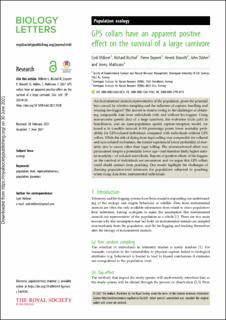| dc.contributor.author | Milleret, Cyril Pierre | |
| dc.contributor.author | Bischof, Richard | |
| dc.contributor.author | Dupont, Pierre | |
| dc.contributor.author | Brøseth, Henrik | |
| dc.contributor.author | Odden, John | |
| dc.contributor.author | Mattisson, Jenny | |
| dc.date.accessioned | 2021-07-02T10:21:14Z | |
| dc.date.available | 2021-07-02T10:21:14Z | |
| dc.date.created | 2021-07-01T12:24:49Z | |
| dc.date.issued | 2021 | |
| dc.identifier.issn | 1744-9561 | |
| dc.identifier.uri | https://hdl.handle.net/11250/2763083 | |
| dc.description.abstract | Are instrumented animals representative of the population, given the potential bias caused by selective sampling and the influence of capture, handling and wearing bio-loggers? The answer is elusive owing to the challenges of obtaining comparable data from individuals with and without bio-loggers. Using non-invasive genetic data of a large carnivore, the wolverine (Gulo gulo) in Scandinavia, and an open-population spatial capture–recapture model, we found a 16 (credible interval: 4–30) percentage points lower mortality probability for GPS-collared individuals compared with individuals without GPS collars. While the risk of dying from legal culling was comparable for collared and non-collared wolverines, the former experienced lower probability of mortality due to causes other than legal culling. The aforementioned effect was pronounced despite a potentially lower age—and therefore likely higher natural mortality—of collared individuals. Reports of positive effects of bio-loggers on the survival of individuals are uncommon and we argue that GPS collars could shield animals from poaching. Our results highlight the challenges of drawing population-level inferences for populations subjected to poaching when using data from instrumented individuals. ecology, population level, representativeness, population dynamics | |
| dc.language.iso | eng | |
| dc.title | GPS collars have an apparent positive effect on the survival of a large carnivore | |
| dc.type | Peer reviewed | |
| dc.type | Journal article | |
| dc.description.version | publishedVersion | |
| dc.subject.nsi | VDP::Zoologiske og botaniske fag: 480 | |
| dc.subject.nsi | VDP::Zoology and botany: 480 | |
| dc.source.volume | 17 | |
| dc.source.journal | Biology Letters | |
| dc.identifier.doi | 10.1098/rsbl.2021.0128 | |
| dc.identifier.cristin | 1919818 | |
| dc.relation.project | Andre: Miljødirektoratet | |
| dc.relation.project | Andre: County administrations in Trøndelag | |
| dc.relation.project | Norges forskningsråd: 286886) | |
| dc.relation.project | Andre: Naturvårdsverket i Sverige | |
| dc.relation.project | Andre: Reindeer Development Fund in Norway | |
| dc.relation.project | Andre: Carnivore Management Boards in regions 6 and 8 | |
| dc.relation.project | Andre: County administration in Troms and Finnmark | |
| cristin.ispublished | true | |
| cristin.fulltext | original | |
| cristin.qualitycode | 2 | |
